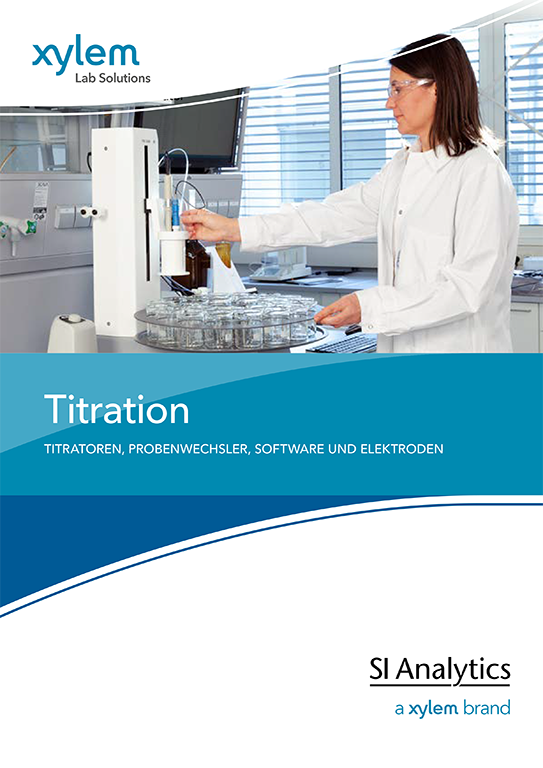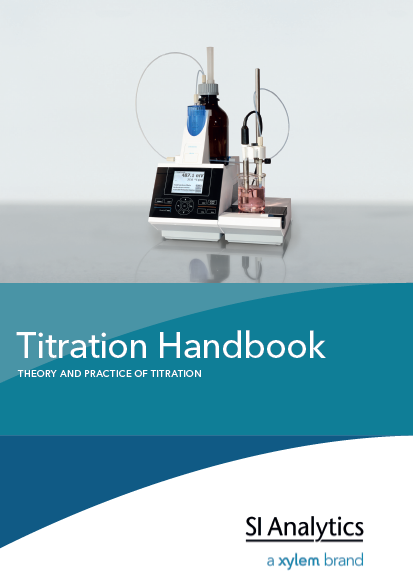In this blogarticle we answer to possible questions, that may occur to you during installation and operation of our instruments. We also respected common questions. You will find more exciting topics about titration in our blog!
Frequently Asked Questions about Titration
1.1. Karl Fischer-Titration
- Up to which water content can volumetric Karl Fischer titrators be used (bottom limit)?
The bottom limit depends on the type and volume of the sample. In practice, the volumetry is used for water volumes of > 100 ppm.
- Can a KF Coulometer also be used for a water content of up to 100%?
This method can also determine 100% water. At 10,000 µg (10 mg) the titration will take a long time. Therefore, the user should not weigh in more than 5,000 µg (= 5 mg) water (one drop of water contains about 35-50 mg of water!).
- Application areas for coulometric or volumetric KF titration?
Coulometry is used to determine µg volumes of water in gaseous or liquid samples without side effects/reactions. Volumetry is used to determine mg volumes of water in gaseous, liquid or solid samples.
- When should a coulometry with a diaphragm be conducted?
The usual application takes place with the cell without a diaphragm. For very small water volumes (< 50 ppm), the diaphragm cell can be advantageous depending on the application.
You can find suitable Karl Fischer titrators for your applications here!
1.2. Electrodes
- Which electrodes are especially suited for ph titrations regarding the setting times?
See the notes under FAQs "Electrodes" or please contact us in person.
- Can I also measure ISE with the titrator?
Yes, the necessary calculations are possible in combination with TitriSoft, also with a sample changer.
- Which electrode is suitable for which application?
This depends on the application. A first reference should be our product catalog and the ph guide (can be downloaded). We will gladly advise you in person.
1.3. Handling
- Which sample preparation must I pay attention to?
This is indicated in detail in the analysis instructions. In most cases, samples are dissolved and titrated directly.
1.4. Automation
- Can a barcode reader be connected?
Yes (except for the TL easy), the type depends on the device.
- How many places are available on a sample changer?
There are sample racks for 12 to 72 samples for two different sample changers.
- When is a sample changer profitable?
If you process 10 samples per day, a sample changer will pay for itself after one year.
You can discover suitable sample changers for titration here!
1.5. Specs
- Our laboratory is equipped with an LIMS system. Can the results of the titrators by SI Analytics be automatically transmitted to our LIMS system?
If you use TitriSoft, the automatic communication with an LIMS system is not a problem. For this, you must simply perform the respective configuration. Without the use of TitriSoft, a data transmission to an LIMS system is currently not possible.
- What is the smallest sample volume that I can titrate with SI Analytics devices?
The sample volume depends on the electrode, titration tip and stirring. A number of customers works with 5 ml samples. We offer a (temperable) titration vessel you can use for titration starting with 3 ml (TZ 1755).
- Can I use this device to only briefly check the ph value?
Yes
- Which titrations (parameters) can I define and up to which definition limit?
This depends on the matrix, the concentration and type of application. Here, statements can only be made for specific applications.
- Are direct measurements possible? Also ISE or LF?
Yes, the necessary calculations are possible in combination with TitriSoft, also with a sample changer.
- Is there a possibility to remove an aliquot part?
Not automatically.
- Can the curve be printed for the TL easy?
Yes, but only in connection with a PC. For the newer models TL 5000 and TL 6000, you can connect a printer directly.
- Can a scale be connected directly to the titrator?
Yes, starting with the TL 5000
- Can the methods be saved to a USB stick?
Yes, starting with the TL 5000
- Are the devices LIMS-capable?
In connection with TitriSoft, the desired data can be made available to an LIMS.
1.6. Titration parameters
- Which parameters can be changed for a titrator and when do I need to change the parameters?
Parameters for the type of added reagent, the stability criteria for the signals of the electrode and the termination of the titration are set. The standard methods encompass well preset parameters. It depends on the application which parameters are set.
- Why is there an immediate termination of the titration right at the beginning when TitriSoft is used?
An EQ was detected. However, the sensitivity have been adapted now.
1.7. Validation
- Why is the titrator slower than manual titration?
During a titration, an electrode picks up measured values in a balanced state. The chemical reaction as well as the response time of the electrode must both(!) be waited for. This is the only way to get objective and correct titration curves with traceable results. A manual titration does not ensure this.
- How high should the consumption be at the most during titration?
We recommend a consumption of 25% to 75% of the burette volume. An attachment with a volume of 20 ml is used most often. Therefore, between 5 and 15 ml must be used.
- Are there standard solutions, e.g. for chloride titrations, that I can use to check the measuring accuracy of the titrator?
We recommend secondary reference material with a certificate issued by the manufacturer. This will include data regarding measuring uncertainty. NaCl is used for chloride titration. With a weight of approx. 58 mg (= 0.058 g), the consumption is approx. 10 ml for a 0.1 molar silver nitrate for solutions. You can also use KCl, but this is not available as reference material.
- Why and how often should a titer determination be conducted?
As a rule of thumb, a titer determination should be performed more frequently for diluted solutions. Alkalines are especially sensitive and the titer should be done at least once a week for those. Only the titer determination with a certified standard allows a correct result.
1.8. Software
- Which system requirements does TitriSoft have?
Dual Core processor 2 GHz with at least 2 GB RAM CD-ROM drive, graphics card with a resolution of 1024x768 and at least 16 K colors, WIN 7, WIN 8 with at least 5 GB of free disc space, 1 available serial interface per configuration, mouse must be connected.
- Which advantages does the software control have?
The methods can be adapted with a lot of flexibility. Methods are created from modules like a house. All information is saved to a database. The methods are nearly independent of the hardware. You can back up your data with a click of your mouse. The entry of sample information is very simple with a list function. The automation is simple. There are very many interfaces for different purposes.
The TitriSoft 3.5 titration software is the optimum solution for your titration tasks.
1.9. Problem solutions
- How fast can I get help if our titrator were to fail? Can you provide a replacement device on short notice?
Contact us! Perhaps we will be able to help you over the phone! In most cases, it is possible to send out a replacement device promptly.
- Troubleshooting: Which measures can help in case of problems?
First, the sensor is always inspected (e.g. by means of calibration or a titration curve with a standard). An important point is the correct dosing: Are there air bubbles? The reaction must take place correctly: is the ph value correct? It is recommended to titrate one standard and one sample and to send the GLP documentation to SI Analytics. Most of the time, the cause of the problem is found quickly.
1.10. Maintenance and care
Coming soon
1.11. Operation
- Are there quick reference guides for the devices?
All introductions contain a detailed table of contents and allow for a quick access to the individual subjects based on their structure. Additional quick reference guides are being planned.
- Which criteria should be considered when selecting a device?
The main criteria are the functions that are necessary for an application (e.g. the number of equivalence points). Then, you must determine the number of different reagents, the automation with the sample changer and more burettes (for example, the TL 5000 or the TL easy 1 EQ or the 1 EP have only one reagent; the TL 6000 has 1 EQ or 2 EPs, more reagents; and the TL 7000/TL 7750 has 2 EQs or 3 EPs, several reagents, additional burettes, sample changers and software support). We will gladly assist you.
Further information can be found in the titration catalog

Find here all components for a manual or automated titration with our high-precision software Titri Soft 3.5 for your use in the laboratory. Learn more about all products in the laboratory environment: coulometric and volumetric titrators, burettes, sample changers, the matching software and the corresponding titration electrodes and all accessories around titration.
Learn more
Find answers in the comprehensive titration handbook
 This is an excerpt from the titration handbook. On 192 pages it offers a compact introduction to the theory and practice of titration. If you are interested, you are welcome to download the practical guide as a PDF or request it as a brochure. And in our database you will find numerous applications for your titration for download. A concrete application example of the determination of acid in bases is described in the blogarticle "how to get correct and reproducible results in titration?". Our titration expert answers further questions from our customers in the blog article FAQ on titration.
This is an excerpt from the titration handbook. On 192 pages it offers a compact introduction to the theory and practice of titration. If you are interested, you are welcome to download the practical guide as a PDF or request it as a brochure. And in our database you will find numerous applications for your titration for download. A concrete application example of the determination of acid in bases is described in the blogarticle "how to get correct and reproducible results in titration?". Our titration expert answers further questions from our customers in the blog article FAQ on titration.
Further questions are answered by our expert in the blog article FAQ Titration. Helpful tips for your application area, you can read in our other blog articles: